
Ramakrishna, also called Ramakrishna Paramahansa, born RamakrishnaChattopadhay, was an Indian Hindu mystic. He was a devotee of the goddess Kali, but adhered to various religious practices from the Hindu traditions of Vaishnavism, Tantric Shaktism, and Advaita Vedanta, as well as Christianity and Islam. He advocated the essential unity of religions and proclaimed that world religions are "so many paths to reach one and the same goal". His parable-based teachings espoused the ultimate unity of diverse religions as being means to enable the realization of the same God. He is regarded by his followers as an avatar.

Sri Sarada Devi, born Kshemankari / Thakurmani / Saradamani Mukhopadhyay, was the wife and spiritual consort of Ramakrishna Paramahamsa, a nineteenth-century Hindu mystic. Sarada Devi is also reverentially addressed as the Holy Mother by the followers of the Sri Ramakrishna monastic order. The Sri Sarada Math and Ramakrishna Sarada Mission situated at Dakshineshwar is based on the ideals and life of Sarada Devi. She played an important role in the growth of the Ramakrishna Movement.
Swami Nikhilananda (1895–1973), born Dinesh Chandra Das Gupta was a direct disciple of Sri Sarada Devi. In 1933, he founded the Ramakrishna-Vivekananda Center of New York, a branch of Ramakrishna Mission, and remained its head until his death in 1973. An accomplished writer and thinker, Nikhilananda's greatest contribution was the translation of Sri Sri Ramakrishna Kathamrita from Bengali into English, published under the title The Gospel of Sri Ramakrishna (1942).
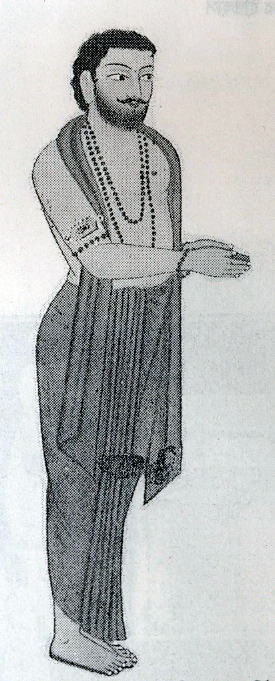
Rāmprasād Sen was a Hindu Shakta poet and saint of 18th-century Bengal. His bhakti poems, known as Ramprasadi, are still popular in Bengal—they are usually addressed to the Hindu goddess Kali and written in Bengali. Stories of Ramprasad's life typically include legends and myths mixed with biographical details.

Mahendranath Gupta, , was a disciple of Ramakrishna and a great mystic himself. He was the author of Sri Sri Ramakrishna Kathamrita, a Bengali classic; in English, it is known as The Gospel of Sri Ramakrishna. He was also an early teacher to Paramahansa Yogananda, a famous 20th-century yogi, guru and philosopher. In his autobiography, Yogananda noted that Gupta ran a small boys' high school in Kolkata, and he recounted their visits, as they often traveled to the Dakshineshwar Kali Temple together. Having a devotional nature, Gupta worshipped the Divine Mother in the form of Kali, and often reflected the wisdom of his guru Ramakrishna in his daily life and mannerisms. Yogananda reverentially regarded Gupta's spirituality, calling him an "Incarnation of purity" and "the greatest man of humility I ever knew."Paul Brunton also narratives a meeting with Mahendra, in his famous memoir, 'A search in secret India'.

Lex Hixon was an American Sufi author, poet, and spiritual teacher. He practiced and held membership in several religious traditions. He believed that all religions are true, which was sparked by his study of the life and teachings of Ramakrishna.
Jeffrey John Kripal is an American college professor. He is the J. Newton Rayzor Chair in Philosophy and Religious Thought at Rice University in Houston, Texas. While chairman of the Religion Department at Rice, he helped found their "GEM" program, with a doctoral concentration in "Gnosticism, Esotericism, and Mysticism".
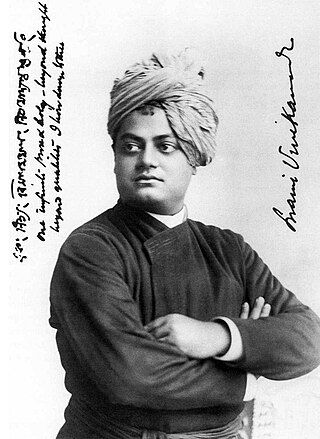
Vedanta Societies refer to organizations, groups, or societies formed for the study, practice, and propagation of Vedanta, the culmination of Vedas. More specifically, they "comprise the American arm of the Indian Ramakrishna movement" and refer to branches of the Ramakrishna Order located outside India.
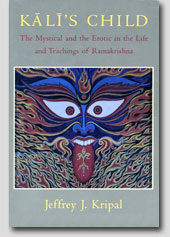
Kali's Child: The Mystical and the Erotic in the Life and Teachings of Ramakrishna is a book on the Indian mystic Ramakrishna by Hindu studies scholar Jeffrey J. Kripal, published in 1995 by the University of Chicago press. It argues for a homoerotic strain in Ramakrishna's life, rituals, and teachings.

Sri Sri Ramakrishna Kathamrita is a Bengali five-volume work by Mahendranath Gupta (1854–1932) which recounts conversations and activities of the 19th century Indian mystic Ramakrishna, and published consecutively in years 1902, 1904, 1908, 1910 and 1932. The Kathamrita is regarded as a Bengali classic and revered among the followers as a sacred scripture. Its expurgated translation into English is entitled The Gospel of Sri Ramakrishna (1942).
Swami Tyagananda is a Hindu Monk of the Ramakrishna Order and presently the head of the Vedanta Society in Boston. Currently, he is also the Hindu chaplain at MIT and Harvard. He has presented papers at academic conferences, and he gives lectures and classes at the Vedanta Society, MIT, Harvard, and other colleges in and around Boston.
Ramakrishna (1836–1886) was a 19th-century Indian mystic whose teachings form the foundation of the Ramakrishna religious movement, Ramakrishna Order and Ramakrishna Mission.
Ramakrishna (1836–1886) is a famous mystic of nineteenth-century India. Ramakrishna never wrote down the details of his own life. Sources for his life and teachings come from the writings of his disciples and live witnesses. Ramakrishna's recorded sayings mainly come from the last four years of his life.
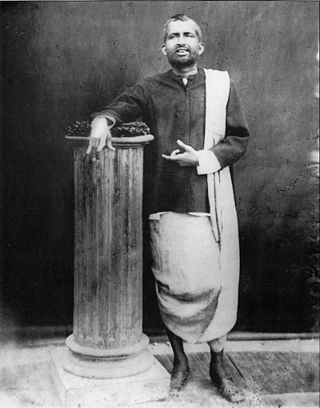
Ramakrishna Paramahamsa (1836–1886) is a famous nineteenth-century Bengali mystic. Ramakrishna was a teacher of popular appeal, speaking in rustic Bengali with stories and parables. Ramakrishna's main teachings included God realization as the supreme goal of life, renunciation of Kama-Kanchana, Harmony of Religions and Jiva is Shiva. Key concepts in Ramakrishna's teachings included the oneness of existence and the unity and truth of all religions.

The Ramakrishna Vivekananda Center of New York is a branch of the Ramakrishna Order of India, founded in 1933 by Swami Nikhilananda. After Nikhilananda's death in 1973, the center was headed by Swami Adiswarananda until the latter's death in 2007. Currently, Swami Yuktatmananda heads the center.
Ramakrishna's samādhi was an ecstasy-filled trance-like state that Indian mystic Ramakrishna used to undergo.
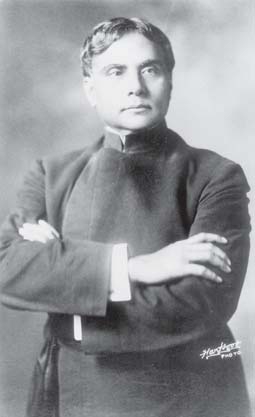
Swami Abhedananda, born Kaliprasad Chandra, was a direct disciple of the 19th century mystic Ramakrishna Paramahansa and the founder of Ramakrishna Vedanta Math. Swami Vivekananda sent him to the West to head the Vedanta Society of New York in 1897, and spread the message of Vedanta, a theme on which he authored several books through his life, and subsequently founded the Ramakrishna Vedanta Math, in Calcutta and Darjeeling.
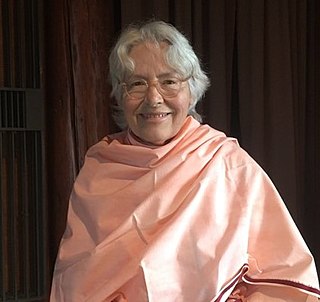
Pravrajika Vrajaprana is a sannyasini or pravrajika at the Vedanta Society of Southern California, affiliated with the Ramakrishna Order. She resides at Sarada Convent in Santa Barbara, California and a writer on Vedanta, the history and growth of the Vedanta Societies.

The relationship between Ramakrishna and Vivekananda began in November 1881, when they met at the house of Surendra Nath Mitra. Ramakrishna asked Narendranath to sing. Impressed by his singing talent, he invited him to Dakshineswar. Narendra accepted the invitation, and the meeting proved to be a turning point in the life of Narendranath. Initially Narendra did not accept Ramakrishna as his master and found him to be a "mono maniac", but eventually he became one of the closest people in his life. Ramakrishna reportedly shaped the personality of Narendranath and prepared him to dedicate his life to serve humanity. After the death of Ramakrishna, Narendra and his other monastic disciples established their first monastery at Baranagar.

Sri Ramakrishna the Great Master, translated by Swami Jagadananda, is an English translation of the Bengali biography Sri Ramakrishna Leela Prasanga, of Sri Ramakrishna, the 19th-century Indian saint and mystic. Its Bengali original was written by Swami Saradananda, which is based on interviews of persons who knew or interacted with him. It is therefore a first-hand source. The original Bengali version published was composed in five volumes and was the first full-scale biography of the saint. This is an eyewitness account and therefore carries more credibility than later books on Sri Ramakrishna. The English translation was first published in 1952. The original Bengali book was written from 1909 to 1919, over a period of ten years, in order to repay the debt incurred for constructing Udbodhan House for Holy Mother Sri Sarada Devi.















